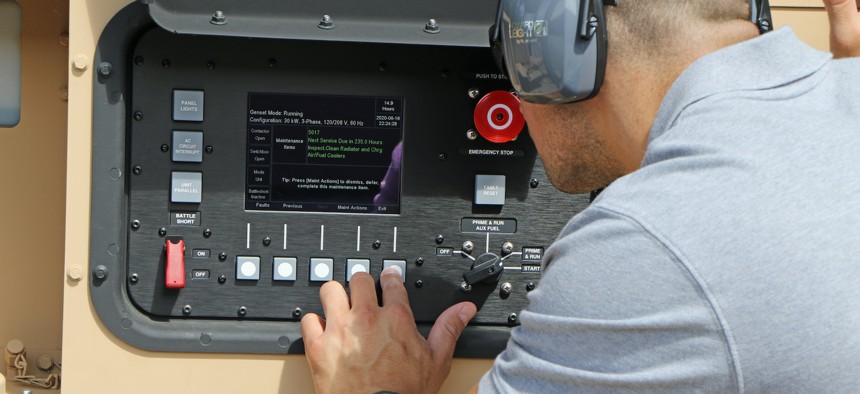
Army engineers working on a hybrid power system in 2020, as part of the Army's research on tactical microgrids. U.S. Army / Daniel Lafontaine
Army to Field Roving Battery Packs in Bid to Trim Fossil-Fuel Use
Green initiatives include testing wheeled, multi-ton battery packs and building energy microgrids at Army installations world-wide by 2035.
The Army’s 25th Infantry Division will run field tests of a multi-ton wheeled battery pack—one that can tote a machine gun—sometime after early 2025, as part of the service’s sweeping plans to reduce its reliance on fossil fuels.
The unit will get several of Plasan’s ATeMM mobile battery packs by December or January, said Paul Farnan, principal deputy assistant Army secretary for installations, energy, and the environment. The 25th Infantry Division specifically requested the packs to reduce fuel consumption, and it will be the first Army unit to field them for tests.
The ATeMM system is a wheeled, multi-ton diesel-charged battery pack that stores 47kWh—well over the 30kWh the average U.S.home uses in a day. It can be controlled with a remote or attached to another vehicle. Some models advertised by Plasan are also armed with machine guns.
The 25th’s interest stems from its position as a light infantry unit that must be highly mobile, as well as the logistical challenges of the Pacific, Farnan said. “They came to us and said ‘hey we really need to look at these things,’” he said, adding that one of the unit’s biggest concerns is “battlefield power generation.”
The 25th’s move comes as part of a broader U.S. Army campaign to cut its reliance on fossil fuels to streamline logistics, secure bases against power disruptions, and field silent but deadly battlefield vehicles.
Among the logistical challenges tied to fuel is that the units resupplying gas to other units are frequently exposed to enemy fire.
Insurgent attacks on fuel convoys killed more than 3,000 soldiers and contractors between 2003 and 2007 in Iraq and Afghanistan, prompting the Defense Department at that time to look into ways to cut fuel consumption.
And though the U.S. presence in the Middle East is now dramatically reduced, a conflict across the vast Pacific region would similarly expose U.S. ships hauling fuel to enemy fire.
“We take casualties protecting fuel lines,” Farnan said. Using less fossil fuel “increases the protection of our and safety of our soldiers by not putting them into harm's way as often” Farnan added.
Army bases are also switching up their source of power; instead of continuing to rely on civilian energy grids, the service is building microgrids at all of its installations. The change will make bases greener, as well as more resilient to natural disasters and attacks on U.S. infrastructure.
Russian and Iranian hackers have probed the U.S. energy grid in the past, and experts say it is also vulnerable to Chinese attacks. Russia in particular has shown itself willing to target grids, first taking down Ukrainian grids through cyber attacks in 2015 and then attempting to devastate the same grids through missile strikes since its invasion of Ukraine began in 2022.
The Army is “very confident” it will meet its goal of creating microgrids for all bases by 2035, Farnan said.
Fort Bliss in particular is leading the charge, Farnan said, noting that the base plans to eventually become carbon neutral. The installation is also home to three camps on its training grounds, which Farnan said the Army will use to trial solar energy systems. The Army will also use a camp tied to West Point to create an energy laboratory.
At the same time, the Army is looking to field more electric vehicles, whose silent engines are perfect for sneaking up on enemy soldiers. In early 2025, the National Training Center at Fort Irwin will receive six electric infantry squad vehicles to test out combat tactics, Farnan said.
The unit in charge of playing the U.S. Army adversary, the 11th Armored Cavalry Regiment, will test out the vehicles in exercises against Army units rotating through the training facility.
The Army hopes to transition to all electric vehicles in its non-tactical fleet by 2035, according to its 2022 climate strategy.
Farnan, a former Navy officer, sees the Army’s focus on energy as a win for his former service as well.
“I've sailed across the Pacific, that's a really big ocean,” Farnan said. “For every tanker we can reduce, that's less Navy combat forces that have to guard those fuel lines across the Pacific.”


